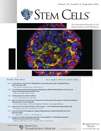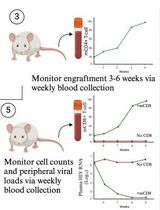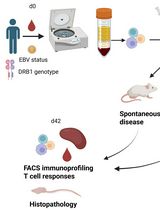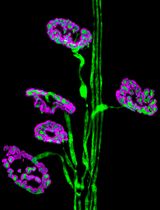- EN - English
- CN - 中文
Mouse Model of Immune Complex-mediated Vasculitis in Dorsal Skin and Assessment of the Neutrophil-mediated Tissue Damage
免疫复合物介导的小鼠背部皮肤血管炎模型及中性粒细胞介导的组织损伤评估
发布: 2017年12月20日第7卷第24期 DOI: 10.21769/BioProtoc.2660 浏览次数: 8843
评审: Anonymous reviewer(s)
Abstract
Neutrophils are the most abundant leukocytes in the blood. In the recent decades, their crucial roles in host defense, immune regulation and tissue damage have been studied in a deeper dimension. In this protocol, we described a mouse model of immune complex-mediated vasculitis in the dorsal skin induced by Arthus reaction, and the subsequent analysis of edema, hemorrhage and tissue damage due to neutrophil activation by means of Evans blue area analysis, histology, and immunofluorescence. This protocol could facilitate the investigation of cellular therapy strategy against over-activated neutrophil-mediated tissue damage.
Keywords: Vasculitis (血管炎)Background
Neutrophils constitute the largest, evolutionary conserved fraction of circulating leukocytes. They lead the first wave of host defense against infection or tissue damage. In vitro models of neutrophil-mediated cellular cytotoxicity are well established (Incani et al., 1981; Dallegri et al., 1984; Saffarzadeh et al., 2012). However, to dissect the complexity of neutrophil-mediated sterile tissue injury, in vivo models are indispensable.
Immune complex (IC)-mediated vasculitis is a disease initiated by the deposition of antigen-antibody complexes in blood vessels, which subsequently lead to complement activation, neutrophil recruitment and activation. The large amount of reactive oxygen species and proteases released from activated neutrophils damage the endothelial lining of the vessel wall and result in edema and hemorrhage (Sindrilaru et al., 2007; Goerge et al., 2008; Feld et al., 2012). The previously described IC-mediated vasculitis induced by Arthus reaction in mouse ears (Sindrilaru et al., 2007) is one of successful models to study the neutrophil-mediated tissue damage. However, with very thin layer of tissue, mouse ear is not suitable to study the effect of potential therapeutic agents in a large volume, for example, with cellular therapy strategy.
In this protocol, we describe a mouse model of IC-mediated vasculitis in dorsal skin, which enables to overcome the above-mentioned pitfall. Furthermore, we provide the details of subsequent analysis of neutrophil induced hemorrhage and tissue injury by Evans blue quantification, together with histological and immunofluorescence techniques. Our results indicated that this mouse model closely resembles the features of tissue damage in human vasculitis patients caused by over-activated neutrophils. This protocol has been applied successfully for our recent discoveries that mesenchymal stem cells suppress hemorrhage and tissue damage in immune-complex mediated vasculitis mediated by over-activated neutrophils (Jiang et al., 2016).
Materials and Reagents
- 1 ml syringe (Omnifix-F) (B. Braun Medical, catalog number: 9161406V-02 )
- Needle 26 G x ½” (B. Braun Medical, catalog number: 4665457-02 )
- 0.22 µm filter (Merck, catalog number: SLGV033RS )
- Cover glasses, 24 x 55 mm, thickness No. 1 (VWR, catalog number: 631-0146 )
- C57BL/6J mice at preferred age of 8-12 weeks, both male and female are suitable for this protocol (THE JACKSON LABORATORY, catalog number: 000664 )
- Anti-bovine albumin antibody produced in rabbit, whole antiserum (Sigma-Aldrich, catalog number: B1520 ) (aliquots store at -20 °C)
- Phosphate buffered saline (PBS) (Thermo Fisher Scientific, GibcoTM, catalog number: 14190144 )
- Formalin solution, neutral buffered, 10% (Sigma-Aldrich, catalog number: HT5014 )
- Xylene (Carl Roth, catalog number: CN80.1 )
- Ethanol (Carl Roth, catalog number: 9065.2 )
- Hematoxylin solution acid acc. to Mayer (Carl Roth, catalog number: T865 )
- Eosin Y solution 0.5% in water (Carl Roth, catalog number: X883 )
- Acetic acid (Carl Roth, catalog number: 3738.1 )
- Roti-histol (Carl Roth, catalog number: 6640 )
- Roti-histokitt (Carl Roth, catalog number: 6638 )
- Target retrieval solution, 10x (Agilent Technologies, DAKO, catalog number: S169984-2 )
- Triton X-100 (Sigma-Aldrich, catalog number: X100 )
- Purified rabbit anti-human/mouse neutrophil elastase/NE antibody (Abcam, catalog number: ab68672 )
- Purified rat anti-mouse Ly6G antibody (Clone RB6-8C5) (Abcam, catalog number: ab25377 )
- Alexa Fluor 488-conjugated goat anti-rat IgG secondary antibody (Thermo Fisher Scientific, Invitrogen, catalog number: A-11006 )
- Alexa Fluor 488-conjugated donkey anti-rabbit IgG secondary antibody (Thermo Fisher Scientific, Invitrogen, catalog number: A-21206 )
- Purified mouse IgG2a κ isotype control (clone C1.18.4) (BD, BD Biosciences, catalog number: 550339 )
- Purified mouse anti-DNA/histone H1 antibody (Merck, catalog number: MAB3864 )
- Purified goat anti-human/mouse myeloperoxidase/MPO antibody (R&D Systems, catalog number: AF3667 )
- Alexa Fluor 555-conjugated goat anti-mouse IgG secondary antibody (Thermo Fisher Scientific, Invitrogen, catalog number: A-21422 )
- Alexa Fluor 555-conjugated donkey anti-goat IgG secondary antibody (Thermo Fisher Scientific, Invitrogen, catalog number: A-21432 )
- 4’,6-Diamidino-2-phenylindole, Dihydrochloride (DAPI) (Thermo Fisher Scientific, InvitrogenTM, catalog number: D1306 )
- Fluorescence mounting medium (Agilent Technologies, DAKO, catalog number: S302380-2 )
- Ketanest S 25 mg/ml (ketamine) (Pfizer, authorization number: 39945.00.00)
- Rompun 2% (xylazine) (Bayer HealthCare, drug identification number: 02169606 )
- Evans blue (Sigma-Aldrich, catalog number: E2129 )
- Rabbit serum (Sigma-Aldrich, catalog number: R9133 )
- Bovine serum albumin (BSA) (Sigma-Aldrich, catalog number: A7906 )
- Goat serum (Sigma-Aldrich, catalog number: G9023 )
- Fetal bovine serum (FBS) (Biochrom, catalog number: S 0615 )
- Anesthesia solution (see Recipe 1)
- Evans blue-BSA solution (see Recipe 2)
- Blocking buffer (see Recipe 3)
- Antibody diluent (see Recipe 4)
Equipment
- Balance
- Heating table (e.g., MEDAX, model: 13801 )
- Animal hair clipper (e.g., Aesculap Exacta Tierschermaschine, B. Braun Medical, Aesculap, catalog number: GT415 )
- Tissue processor (e.g., Leica Biosystems, model: Leica TP1020 )
- Digital camera (e.g., Panasonic, model: Lumix DMC-LX7 )
- Fluorescent microscope: Zeiss Axiophot microscope with an AxioCam digital color camera and AxioVision software v4.7 (Carl Zeiss)
- Steam cooker (e.g., Braun MultiGourmet Food Steamer, Braun, model: FS 20 )
- Slide staining trays (e.g., StainTrayTM Systems for 20 Slides with Base with Black Cover, Simport, catalog number: M920-2 )
Software
- ImageJ
- Graphpad Prism
- AxioVision (ZEISS)
Procedure
文章信息
版权信息
© 2017 The Authors; exclusive licensee Bio-protocol LLC.
如何引用
Jiang, D., de Vries, J. C., Muschhammer, J., Sindrilaru, A. and Scharffetter-Kochanek, K. (2017). Mouse Model of Immune Complex-mediated Vasculitis in Dorsal Skin and Assessment of the Neutrophil-mediated Tissue Damage. Bio-protocol 7(24): e2660. DOI: 10.21769/BioProtoc.2660.
分类
免疫学 > 动物模型 > 小鼠
细胞生物学 > 组织分析 > 组织染色
您对这篇实验方法有问题吗?
在此处发布您的问题,我们将邀请本文作者来回答。同时,我们会将您的问题发布到Bio-protocol Exchange,以便寻求社区成员的帮助。
Share
Bluesky
X
Copy link















